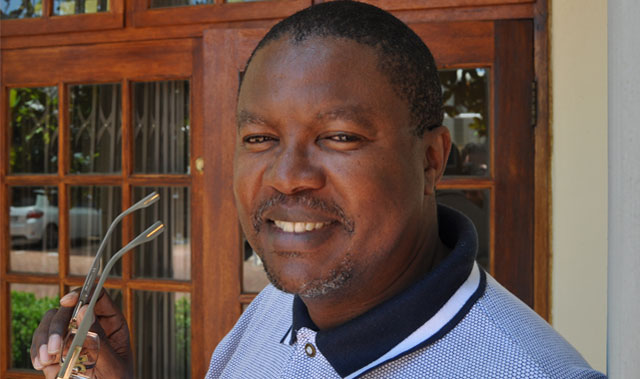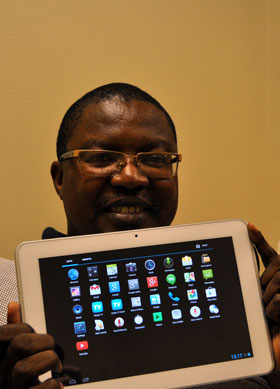
The company behind the design and development of South African-manufactured smartphones and tablets is set to begin production of the devices as early as this month, with the products expected to be available to consumers soon.
TechCentral first revealed in October last year that two independent, black-led companies, Seemahale Telecoms and CZ Electronics, were gearing up to offer the locally manufactured devices in 2014.
Seemahale makes networking and broadcasting equipment and last year acquired a 51% stake in CZ Electronics, a company founded in 2002 following the purchase of a Boksburg-based factory that used to make equipment in South Africa for France’s Alcatel Lucent on behalf of Telkom and other clients.
Seemahale CEO Thabo Lehlokoe says the company plans to offer two smartphone models, a cheaper unit with a 4-inch screen and a pricier (though still affordable) 5-inch device. Both phones will run Android 4.3 and neither will have a proprietary Android interface layer favoured by big phone makers like Sony, Samsung and HTC.

The 5-inch model will cost about R2 500 and will include a 960×540-pixel LCD capacitive-touch screen, 4GB of flash-based storage, a dual-core 1,5GHz processor, a microSD slot that supports cards up to 32GB in size, antennae for 2G and 3G connectivity up to 21Mbit/s, an FM radio, Bluetooth, Wi-Fi, GPS and a 2 250mAh battery.
The 4-inch phone will cost less than R1 200 – a highly aggressive price for a feature-rich device. It will include support for 2G and 3G networks, will ship with 4GB of storage, and will have up to 1GB of RAM, as well as Bluetooth, Wi-Fi, GPS and a 5-megapixel rear-facing camera. Screen resolution is 800×480. Its battery will either be a 1 500mAh or 1 700mAh model.
Lehlokoe says Seemahale will reveal the names of the products when they are launched officially to the market in the coming weeks.
Both phones will come in dual-Sim models, though Vodacom has asked the company to produce a single-Sim version, too. “Our research shows most people would prefer a dual-Sim phone. They’d rather have one than two phones. But if the phone is being subsidised, the operators would need a single Sim.”
Despite the low prices of the two phones, Lehlokoe says Seemahale will make a “decent profit”.
“We are very aggressive because we want uptake in the market. We didn’t skimp on the specs. For the price, it will be one of the better devices out there. We want to encourage people, to make it affordable,” he tells TechCentral.
Lehlokoe believes there is a big gap in the market between ultra-low-cost handsets and high-end smartphone models. He says consumers are looking for “decent phones with decent specs but at a much better price”.
“People will see we have good products,” he says. “We are targeting people who are using feature phones but who want a smartphone. We said: ‘Let’s give them a big enough screen to browse the Internet and read documents, but also give them a long enough battery life.’”
Though higher-resolution devices are available, these tend to be much more expensive, especially full high-definition phones. “If you look at photos on our phones, they are good quality. They are not grainy. We try to strike a balance. We try to give people a good experience to do what they need to do, but without it killing their pockets. Anything that is unnecessary you don’t want to put in there. We are very clear about who we are targeting and what we want to do.”
By the end of this month, Seemahale should have the first locally produced devices ready, Lehlokoe says.
CZ Electronics and Seemahale are importing the printed circuit boards that they’ll be using, but placement of all the components, the housing assembly, the manufacture of cables and accessories, and the printing of manuals and packaging is being done in South Africa.

They have ordered enough components from suppliers in China to manufacture “a few thousand” devices. “We have been talking to operators and retailers and we expect to take our first order any time now.”
Lehlokoe says the Boksburg factory is geared for volume if demand is strong. “We can manufacture between 100 000 and 150 000 devices a month,” he says. “If we create 5 000 devices a month, we will create between 50 and 100 jobs.”
The company also plans to bring two Android-powered tablets to market, starting with a 10-inch model and followed by a 7,8-inch device. The 10-inch version has a 1 280×800-pixel display, along with mini HDMI port, front- and rear-facing cameras and a Sim slot. It will have an 8 600mAh battery. There’s Wi-Fi, GPS and 3G cellular, too.
The 7,8-inch tablet, meanwhile, will have a 1 024×768 panel, two cameras, Wi-Fi and 5 000mAh battery, along with Wi-Fi, GPS and 3G cellular. The smaller tablet is expected to cost less than R3 000, while the bigger model will fetch about R3 500.
The 10-inch tablet and 5-inch smartphone, which will go on sale first, have already been “type approved” by telecoms regulator Icasa, while the same devices have been tested in Vodacom’s labs where they performed well in various radio frequency tests.
Lehlokoe says his company is already working on the next versions of the phones and tablets, and firming up plans to take the products to other African markets. He has also met with a number of chipset manufacturers, including Intel and Qualcomm, with a view to establishing direct relationships.
Future plans include offering manuals in a range of local languages, including English, Afrikaans, Sotho and Zulu. “The intention is also to have Swahili for East Africa, plus Arabic, French and Portuguese, and you cover pretty much most of Africa. The first devices will probably go with English and Afrikaans, but we’re already working on the other languages. The next generation will come with all the other languages,” he says.
There are also plans to offer a range of accessories to complement the phones and tablets, including a locally manufactured charging unit as well as a solar charger, a Bluetooth speaker and headphones. Accessories that will carry the “IO Legacy” logo will have been made in South Africa. — (c) 2013 NewsCentral Media




